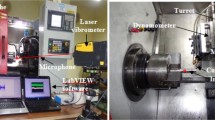Abstract
Metal cutting mechanics is quite complicated and it is very difficult to develop a comprehensive model which involves all cutting parameters affecting machining variables. In this study, machining variables such as cutting forces and surface roughness are measured during turning at different cutting parameters such as approaching angle, speed, feed and depth of cut. The data obtained by experimentation is analyzed and used to construct model using neural networks. The model obtained is then tested with the experimental data and results are indicated.
Similar content being viewed by others
References
Alajmi, M. S., & Alfares, F. (2007). Prediction of cutting forces in turning process using De-Neural Networks. Artificial Intelligence and Applications, AIA 2007, 2/12/2007–2/14/2007, Innsbruck, Austria.
Chou, Y.K., Evans, C.J., Barash, M.M.: Experimental investigation on CBN turning of hardened AISI 52100 steel. Journal of Materials Processing Technology 124, 274–283 (2002)
Dimla, D.E. Sr.: Application of perceptron neural networks to tool state classification in a metal turning operation. Engineering Applications of Artificial Intelligence 12, 471–477 (1999)
Feng, C.X., Wang, X.: Development of empirical models for surface roughness prediction in finish turning. International Journal of Manufacturing Technology 20, 348–356 (2002)
Feng, C.-X.J., Yu, Z.-G.(Samuel), Kusiak, A.: Selection and validation of predictive regression and neural network model based on designed experiments. IIE Transactions 38, 13–23 (2006)
Haci, S., Faruk, U., Yaldiz, S.: Investigation of the effect of rake angle and approaching angle on main cutting force and tool tip temperature. International Journal of Machine Tools & Manufacture 46(2), 132–141 (2006)
Liang, M., Mgwatu, M., Zuo, M.: Integration of cutting parameter selection and tool adjustment decisions for multipass turning. International Journal of Advanced Manufacturing Technology 17(12), 861–869 (2000)
Özel, T., Karpat, Y.: Predictive modeling of surface roughness and tool wear in hard turning using regression and neural networks. International Journal of Machine Tools and Manufacture 45(4–5), 467–479 (2005)
Rahman, M., Zhou, Q., Hong, G.S.: On-line cutting state recognition in turning using a neural network. The International Journal of Advanced Manufacturing Technology 10(2), 87–92 (1995)
Sharma, V.S., Sharma, S.K., Sharma, A.K.: Tool wear estimation for turning operations. Journal of Mechanical Engineering 57(3), 141–168 (2006)
Simpson, P. K. (1992). Foundations of neural networks, artificial neural networks. IEEE press.
Singh, D., Rao, P.A.: Surface roughness prediction model for hard turning process. The International Journal of Advanced Manufacturing Technology 32(11–12), 1115–1124 (2007)
Srinivasa Pai, P., Nagabhushana, T.N., Ramakrishna Rao, P.K.: Flank wear estimation in face milling based on radial basis function neural networks. International Journal Advanced Manufacturing Technology 20(4), 241–247 (2002)
Thiele, J.D., Melkote, S.N.: Effect of cutting edge geometry and workpiece hardness on surface generation in the finish hard turning of AISI 52100 steel. Journal of Materials Processing Technology 94, 216–226 (1999)
Zuperl, U., Cus, F.: Optimization of cutting conditions during cutting by using neural networks. Robotics and Computer Integrated Manufacturing 19, 189–199 (2003)
Author information
Authors and Affiliations
Corresponding author
Rights and permissions
About this article
Cite this article
Sharma, V.S., Dhiman, S., Sehgal, R. et al. Estimation of cutting forces and surface roughness for hard turning using neural networks. J Intell Manuf 19, 473–483 (2008). https://doi.org/10.1007/s10845-008-0097-1
Received:
Accepted:
Published:
Issue Date:
DOI: https://doi.org/10.1007/s10845-008-0097-1




